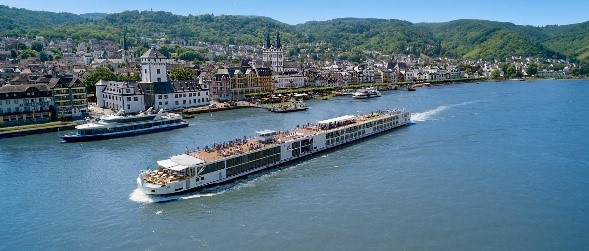Two Weeks in France, Part Two: The Rhone River
The rivers of Europe meander through ancient walled towns and past castles perched high on hilltops. Cruising these beautiful waters on longships or barges can take you on adventures in history, cuisine, and culture. Touring capital cities, medieval royal residences, and cobblestoned streets in lovely old villages is not only fun, but it’s a way to bring history to life. Our recent trip to France included a week-long cruise on a Viking Longship on the Rhone River, which is a fantastic experience in and of itself. But, of course, a choice of many daily excursions brought exposure to compelling new experiences.

This was our second European river cruise, and I would look forward to booking another on some other river or canal. It is such a comfortable way to travel. The best part is unpacking your suitcase for the eight days or more that you will be a guest on one of these ships. There is a choice of stateroom size/amenities, and you can choose one of the compact lower level rooms with smaller windows, a mid-level room with a veranda, or a two-room suite. There is good reason to assume you won’t be in your room very much, so the size may not be so important. But sitting on your own veranda, enjoying a cocktail, and reading a book saved for this perfect occasion while the ship is cruising is very pleasant. Some of the travel time is in the evening, and it can be delightful to go to the terrace at the front of the ship or climb to the upper deck to get a more panoramic view.
On one level of the ship there is a dining room that sees sumptuous buffets for breakfast and lunch; however, there are also menus for both lunch and dinner. Wine flows freely for lunch and dinner, and saving room for delicious desserts is a must. Fresh ingredients are brought onboard during the cruise, and menu selections bring difficult choices for diners who want to try several different options (which you can do if you so choose). You never go hungry! Above the dining room, there is a lounge which offers a broad variety of liquors from excellent house/call alcohol to premium. You can opt for a beverage package that allows you unlimited access to an expanded list of drinks.
Lyon

Our trip began in Lyon, known for its excellent cuisine (and nearly 2000 restaurants) and its history of producing exquisite silks in the 19th century. We did a bus tour of some of the highlights of this city of over 500,000 people (metropolitan – over two million). There was some time for shopping, and my husband and I particularly enjoyed some of the antique art shops that sold fine and interesting old prints. We also stopped in chocolate shops and locally milled soap shops. The area around Lyon is where Beaujolais wine is made, so we visited a vineyard and learned much about the fine art of growing grapes. Some of the plants were quite old, perhaps 80 or more years. While we tasted some of these local wines, we better appreciated all that goes into the production. Not far from Lyon is Vienne, a city with steep hills and the remains of its first-century Roman history. You can see a 13,000-seat Roman theatre that was only excavated and brought back to life in 1922.

Tournon
In Tournon, we opted to take a steam train (de l’Ardeche) up the Doux Valley into the mountains to an area that is not accessible by roads. The beautiful vista made for an enjoyable trip, but the mechanics of turning the train engine around at the top was also fascinating and worthy of a few pictures. This same day we visited Viviers, one of the few remaining European walled cities. Like many European cities, it has its magnificent, though small, cathedral built in the 12th century.
Avignon

Avignon, the “City of Popes,” was our next stop. Seven pontiffs lived in the opulent Palace of the Popes in the 14th century, one of the optional tours for the day. Avignon also is a walled city, and the area (Provence) is known for wonderful regional foods such as bouillabaisse or ratatouille. There were many tour choices, but we opted to visit one of the many fine wineries that produce the famous Châteauneuf-du-Pape (meaning “new castle of the Pope”). On one episode of “M.A.S.H.,” the character Charles Emerson Winchester III touts his prized bottle of Châteauneuf-du-Pape to his tent-mates, which doesn’t impress them, but which caught my attention since we had just been there. There are over 300 vintners that are allowed to use this name for their product, one of many strict controls that govern the wine producers in the area. Our final excursion was in the town of Arles. Numerous Roman buildings remain, and one that we visited was an arena where gladiators fought. In the 9th century, Arles was the capital of the Kingdom of Arles, long ago reabsorbed into France.
At every stop, guests had multiple choices for excursions with at least one included tour at each stop in the cruise package. The offerings listed the level of difficulty and the duration of each outing, so it was easier to choose based on how much energy you were willing to expend for that day. There are so many magnificent river cruises in Europe to choose from, and the number of river cruises in other parts of the world is increasing each year. Would I select one again? Absolutely. They are comfortable, the food is exquisite, and the small guest list (180 more or less) gives the sojourner a chance to mingle with others from all over the world. We got to know people from such places as Australia and the United Kingdom (a member of the British House of Lords). Those shared meals were the bonus to fascinating tours and experiences.

Diane Repass is a retired tenured assistant professor
from The University of Dubuque and now a beloved
writer for Plaid Swan Inc. She received her M.A. from
The University of Northern Iowa in Cedar Falls, Iowa.


I’m making a copy of your terrific travelogues to go with my pictures (in case I ever get them printed)!